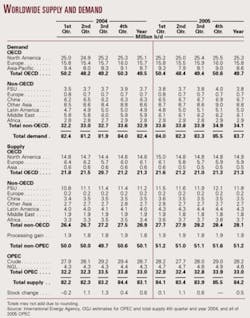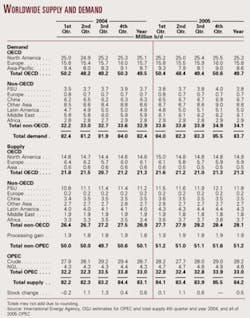With worldwide oil demand growth slowing and inventories of crude and products abundant in countries of the Organization for Economic Cooperation and Development, the call for crude from the Organization of Petroleum Exporting Countries this year will decline.
Members of the OECD will supply the same amount of oil this year as last, but countries outside the organization will boost output in 2005, according to International Energy Agency estimates. The Paris-based agency expects increases in production from the former Soviet Union (FSU), Latin America, and Africa.
OECD oil demand
This year, North American oil demand will increase to 25.29 million b/d from 25.08 million b/d in 2004, with the bulk of the gain in the US.
IEA estimates place 2005 US demand growth at 170,000 b/d, pushing average consumption to 20.63 million b/d. The remainder of the North American demand growth will be about evenly split between Mexico and Canada.
Modest demand growth in OECD Europe will nearly offset a decline in oil demand in OECD Asia. Japanese demand will average 15.81 million b/d, up from 15.73 million b/d last year, but IEA expects demand in South Korea to wane to 5.36 million b/d from 5.47 million b/d.
Non-OECD demand
China's demand growth, which will slow following several years of rapid expansion, will lead the nations outside the OECD in 2005. Demand in the FSU and the Middle East will grow this year but also slower than during 2004.
IEA said that the two drivers of last year's 14.7% oil demand growth in China were economic expansion and an electric power generation shortfall that fueled a surge in diesel demand for stand-alone backup generators. The agency is confident that economic growth will continue to drive oil demand in China as it sees electric power generation's future effects on oil demand as more unpredictable now that nonoil electric power generation capacity is being added.
FSU oil demand in 2005 is estimated at 3.82 million b/d, up from 3.71 million b/d last year. And IEA forecasts that average Middle East oil demand this year will climb to 6.14 million b/d from 5.88 million b/d in 2004 and 5.56 million b/d in 2003. Part of the reduction in oil demand growth in the Middle East is attributed to the increased use of natural gas instead of oil in the industrial sector and in electric power generation.
Oil output
Oil supply from the OECD will be unchanged from last year at 21.3 million b/d, but there will be some redistribution of output.
North American oil supply will grow to 14.9 million b/d from 14.6 million b/d last year. Meanwhile, oil supply in OECD European countries will decline to 5.9 million b/d from 6.1 million b/d, and OECD Asian output will average 500,000 b/d, down 100,000/b/d from a year earlier.
Among the non-OECD countries, Russia again will be the output growth leader. Estimates put Russia's 2004 production of crude oil and NGL at 11.2 million b/d, up from 10.3 million b/d in 2003 and 9.4 million b/d a year earlier.
Russian output this year will grow more modestly to 11.8 million b/d, restrained by a host of factors. These include uncertainties over export capacity, a tightening of government controls on reservoir management, and possible fallout from the sale of the production unit of OAO Yukos, IEA said in its December Oil Market Report.
Oil supply from non-OECD Europe, China, and other Asian countries will hold steady this year, but IEA expects 300,000 b/d of growth in supply from both Latin America, up to 4.3 million b/d, and Africa, up to 3.7 million b/d.
Call on OPEC
The official output ceiling for members of OPEC excluding Iraq effective from Nov. 1, 2004, is 27 million b/d. All members of the organization in the final quarter of last year produced an estimated 29.4 million b/d of crude and 4.4 million b/d of NGL. This resulted in a stockbuild of 400,000 b/d for the quarter.
On Dec. 10, 2004, members of OPEC met in Cairo and agreed to limit overproduction. If output is restrained in the first quarter of this year to an average 28.2 million b/d, there will still be adequate worldwide supply and enough crude for a small increase in inventories.
Further, if inventories are to build by the same amount during the second quarter as during the same 2004 period, crude supply from OPEC needs to be only 27.7 million b/d if, as IEA estimates, NGL production from organization members reaches nearly 5 million b/d.
The amount of NGL that OPEC produces, as reported by IEA, has grown during the past few years and is estimated to average 4.8 million b/d this year. OPEC quotas do not apply to NGL.
To limit the build in OECD oil inventories to 600,000 b/d during the third quarter, OPEC output of crude need average only 28 million b/d. Last year during this period, stocks built by 1.3 million b/d, when the organization's output, including Iraq, averaged 29.2 million b/d.
In 2004, OPEC was pressured to supply the market with more crude in hopes that doing so would temper high oil prices, but forces other than physical supply were forcing up the price. Factors in the oil price were the war in Iraq, a terror premium, and a high level of speculative activity in the oil futures market. All the while, the oil market was well supplied, as inventories proved.
If OPEC crude output averages 29 million b/d in the fourth quarter of this year and IEA's demand projections are accurate, the market will balance with no additional supply going into storage. For all of 2005, the average stockbuild will be 500,000 b/d, down from last year's 600,000 b/d.

